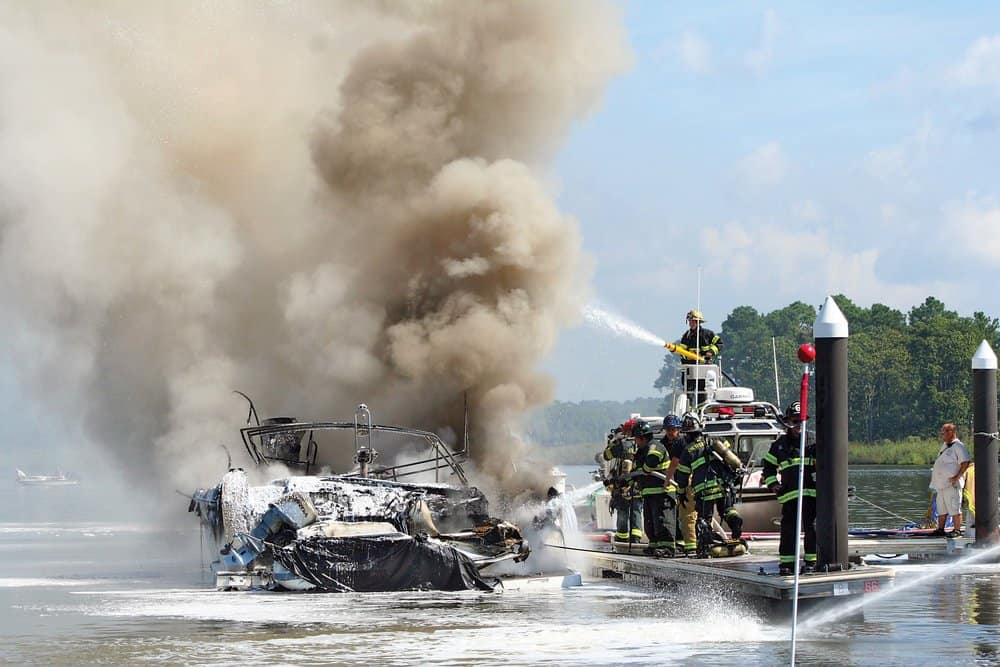by Tom Hale
There is an old saying I learned from my father: “A fire at sea can ruin your whole day.” The comment was predicated upon a boat explosion at the fuel dock in our harbor. That saying was borne out again this past August when a family in Southern Maryland saw their boat blow up at the launch ramp. Fortunately no one was seriously hurt in either incident. But why do these accidents happen, and how can boaters prevent them?
Shortly after World War II, the recreational boating industry blossomed. The burgeoning auto industry brought the price of small gas engines down significantly just as boatbuilders were beginning to experiment with fiberglass construction. Suddenly pleasure boats were affordable to a growing middle class looking for recreational outlets.
By the 1970s the U.S. Coast Guard had begun to document a surge in boat fires and explosions, and its newly created Office of Boating Safety set about finding ways to identify and eliminate the risks involved. Basically, to have an explosion there must be a source of fuel and a source of ignition. Coast Guard inspectors identified fuel tank leaks and hose failures as the principle sources of raw fuel, while flammable vapors came from carburetors that were sitting on hot engines. Sparks from engine starters, distributors or alternators were enough to set it all off.
The USCG research resulted in stringent standards for fuel hoses and fuel tank construction, and mandated the installation of ventilation systems that include an electric blower. Further, any electrical device in the engine compartment or spaces connected to it must be “Ignition Protected”—that is, any sparks, whether intentional or not, must be contained so as to prevent the inadvertent ignition of any flammable hydrocarbon gas mixture. With these regulations in effect, boat fires and explosions became a rarity and virtually nonexistent in boats that were in compliance.
So what happened this summer in Southern Maryland? Without even looking at the Fire Marshal report, which had not been released at this writing, I can take a pretty good guess. Over the course of my career managing boatyards, I’ve been involved with a number of similar fires, and there seems to be a common thread.
Probably the most common scenario goes something like this: An old boat pulls up to the fuel dock and fills the gas tank. The owner turns on the blower for four minutes and starts the engine. Shortly after the boat leaves the dock, it blows up.
What happened?
As boats get older, gasoline, ozone and time can affect rubber hoses. Pumping Ethanol-laced fuel into your tank speeds up the process. If you see a bad hose leading to the carburetor, you will replace it. But who looks at the fuel fill hose? It’s usually hidden from sight, so you don’t see the deterioration. One day you fill your old boat with fuel and the fuel fill hose starts to leak raw gasoline into the bilge. You can run your blower for four minutes or 40, but it will not remove the vapor coming from the leaked gas. The vapor by itself is too concentrated to ignite without someone actually lighting a match, but as the boat pulls away from the dock, the engine begins pulling in lots of fresh air and the dense vapor mixture in the engine compartment thins to below 8 percent—low enough to ignite. Now all it needs is an errant spark to explode.
Unless you’ve literally pulled great-grandpa’s boat out of the barn, your boat’s systems more than likely met the USCG ignition protection requirements when the boat was first launched. But if the engine is 15 to 20 years old, it’s gone through a lot of changes. If you bought it used, you may not be aware of past repairs. There could well be replacement automotive parts on board that lack ignition protection.
Gasoline marine engines are standard automotive blocks. If your alternator, starter or distributor goes bad, you have to replace it. You may wonder why you should pay $150 for a marine alternator when a $50 Chevy alternator will do the trick. A $50 Chevy starter looks just like a $200 marine starter. It even bolts up to the same holes. Anyone familiar with car engines can get a boat engine to run, and all too frequently, automotive components wind up in older boats.
But here’s the rub: When a car’s fuel hose leaks, the gas falls harmlessly on the ground and evaporates far from any source of ignition. In a boat, leaking fuel lands in the cold bilge, where it evaporates and fills the enclosed space with vapor.
Turning on the blower—even if you leave it on—will not remove the vapor from spilled gasoline in the bilge. The blower is designed to remove the vapor that has evaporated out of the carburetor when the warm engine is shut down—when you pull up to a fuel dock, for example. It has no effect at all on fumes lingering in the bilge.
Bear in mind that it’s not easy to create a gasoline-fueled explosion. It requires a rather precise mixture of gasoline vapors and air. If the vapors are too thin (less than 1.5 percent), the mix cannot explode. If the vapors are too dense (above 8 percent), it cannot explode. If there is no spark, it cannot explode.
Ignition protection is what keeps the sparks from flying in a marine engine, which is why it is vital for boatowners to use marine-certified “Ignition Protected” replacement parts on their marine engines. It also doesn’t hurt to take a good look at all of your fuel hoses from time to time, especially if you’ve been using Ethanol fuel. The bottom line is easy: that $300 marine grade replacement part is a heckuva lot cheaper than losing your boat to a fire—or worse, injuring someone you love.



